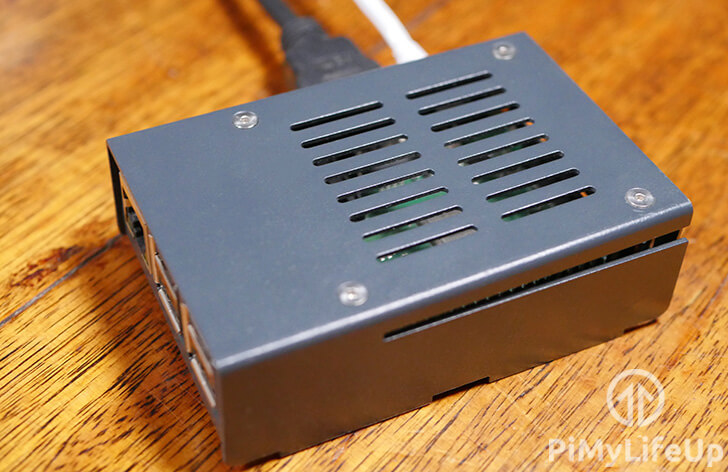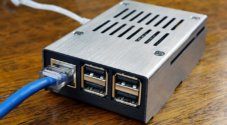In this tutorial, we will be walking you through the steps of setting up a DNS server on your Raspberry Pi.

A DNS server is what handles translating a domain name such as pimylifeup.com to its end destination. It’s what helps transform IP addresses from something like “210.345.231.345” to the more user-friendly domain name system.
By setting up a DNS server on your Raspberry Pi, you can use it to improve the time it takes for your computer to perform DNS requests.
The DNS server on the Pi will make requests to other DNS servers to determine the IP for that request and cache it. This means when you request that same domain name again, you will be returned that request almost instantly.
If you want to set up a DNS server on your Raspberry Pi that has a bit of extra functionality out of the box, then we recommend you check out our guide on setting up Pi-Hole.
Pi-Hole is a software package that comes with a bundle of extra functionality such as domain name blocking as well as an easy to use interface that allows you to manage your DNS setup with ease.
If you want to learn how to change the DNS your Raspberry Pi uses, then be sure to follow our DNS settings guide.
Before you get started with setting up your Raspberry Pi DNS server, you should first make sure you have your Pi set up to use a static IP address.
Equipment List
Here is all the equipment that I recommend for this Raspberry Pi DNS Server tutorial.
Recommended
Optional
Setting up a DNS Server on the Raspberry Pi
1. In this tutorial, we will be making use of the Raspbian operating system. Other operating systems might work, but is not guaranteed.
Before we can set up our Raspberry Pi as a DNS server, we must ensure everything is up to date.
We can do this by running the following two commands on our Raspberry Pi.
sudo apt update
sudo apt upgradeCopy2. Once the update has completed, we can proceed to install the software that we will be using to setup our Pi as a DNS server.
This software package that we are installing is called DNSmasq. DNSmasq is a lightweight and straightforward DNS server that was designed with small-scale networks in mind.
Thanks to its lightweight nature, DNSmasq is the perfect solution for setting up a DNS server on a Raspberry Pi as it won’t drain its limited resources.
We can install dnsmasq to our Raspberry Pi by running the following command.
sudo apt install dnsmasqCopyConfiguring the DNS Server
1. Now that we have gone ahead and installed the dnsmasq software to our Raspberry Pi, we should now make some configuration changes to it.
The changes that we will make to its configuration file will allow your Raspberry Pi to work as a better DNS server.
We can begin making modifications to the file by running the following command.
sudo nano /etc/dnsmasq.confCopyTo find the sections that you are after easier, you can make use of CTRL + W to search for the required text.
Find
#domain-neededCopyReplace with
domain-neededCopyThis option changes the DNS server so that it does not forward names that do not contain a dot (.) or a domain name (.com) to upstream nameservers.
Doing this will keep any plain names such as “localhost” or “dlinkrouter” to the local network.
Find
#bogus-privCopyReplace with
bogus-privCopyThis option stops the DNS server from forwarding reverse-lookup queries that have a local IP range to the upstream DNS servers.
Doing this helps prevent leaking the setup of a local network as the IP addresses will never be sent to the upstream servers.
Find
#no-resolvCopyReplace with
no-resolvCopyWith this option, we tell dnsmasq not to read the “/etc/resolv.conf” file for its upstream nameservers and to instead rely on the ones specified in its configuration.
Find
#server=/localnet/192.168.0.1CopyReplace with
server=8.8.8.8
server=8.8.4.4CopyUsing this we instruct dnsmasq to utilize Googles DNS servers for its upstream nameservers.
You can also make use of other public DNS’s such as CloudFlare’s DNS or OpenDNS.
Find
#cache-size=150CopyReplace With
cache-size=1000CopyWith this option we are increasing the amount of DNS requests that the dnsmasq software will cache.
By increasing its cache size, we should be able to improve our Raspberry Pi’s DNS Servers overall performance and reduce the time to perform DNS lookups.
2. With the changes made to the configuration file, you can now save the file by pressing CTRL + X then Y followed by ENTER.
3. As we have made changes to dnsmasq’s configuration, we will need to restart its service so that it reads in our changes.
We can restart dnsmasq by running the following command.
sudo systemctl restart dnsmasqCopy4. Because we made some changes to the dnsmasq service, we should check to ensure that it has started up correctly.
We can check the status of our DNS server by using the command below..
sudo systemctl status dnsmasqCopyIf the status shows as “Active: active (running)” then you now have your Raspberry Pi successfully running as a DNS Server.
You should now be able to point your device to the Rasberry Pi’s IP address to utilize it as a DNS server.
Testing the Raspberry Pi DNS Server
1. If you want to test the results of your Raspberry Pi DNS server without changing your DNS you can by making use of the “dig” tool.
To use the dig tool on your Raspberry Pi, you will need to first install the “dnsutils” package by running the command below.
sudo apt install dnsutilsCopy2. With the “dnsutils” package installed to the Raspberry Pi, we can go ahead and query our Pi DNS server by running the command below.
Using “@localhost” we are telling the dig tool to utilize the localhost’s DNS server for the DNS lookup.
dig pimylifeup.com @localhostCopy3. From this command, you should get a response as we have below.
This response shows the answer that the dig software retrieved from the Raspberry Pi’s DNS server.
From this response, you can see how long the query took to complete as well as additional information.
pi@raspberrypi:~ $ dig pimylifeup.com
; <<>> DiG 9.11.5-P4-5.1-Raspbian <<>> pimylifeup.com
;; global options: +cmd
;; Got answer:
;; ->>HEADER<<- opcode: QUERY, status: NOERROR, id: 40018
;; flags: qr rd ra; QUERY: 1, ANSWER: 2, AUTHORITY: 0, ADDITIONAL: 1
;; OPT PSEUDOSECTION:
; EDNS: version: 0, flags:; udp: 512
;; QUESTION SECTION:
;pimylifeup.com. IN A
;; ANSWER SECTION:
pimylifeup.com. 257 IN A 104.25.42.22
pimylifeup.com. 257 IN A 104.25.43.22
;; Query time: 45 msec
;; SERVER: 127.0.0.1#53(127.0.0.1)
;; WHEN: Thu Aug 01 08:04:35 BST 2019
;; MSG SIZE rcvd: 75Copy4. If you rerun the command, you will notice that the query time will be significantly reduced as it can retrieve the DNS request from the cache.
As we are requesting from localhost, you should have a query time close to 0 msec.
;; Query time: 0 msecCopyHopefully, by now, you will have successfully set up your Raspberry Pi to act as a DNS server for your network. If you run into any issues or have any feedback, feel free to drop a comment below.










Can you explain how do I point to this DNS server from a computer outside the LAN?
Hi Ali,
You would need to port forward port 53 to your Raspberry Pi. Then point your outside device to your networks public IP address. If you don’t have a static IP, you might want to consider setting up a dynamic DNS provider.
Cheers,
Emmet
Does this coexist with an installation of PiHole, or is it one or the other?
Hi Doug,
As Pi-Hole works by operating as your DNS server, I can’t see this guide working well alongside it.
Is there any particular reason you might want to run both on your Raspberry Pi?
Cheers,
Emmet
thanks man, good guide
Do I need to change settings in my router to point to my raspberry?
Hi Juabjo,
You can either change your router to point to it or change each of your individual devices to point to it.
Just make sure that your Raspberry Pi is getting a static IP address from your router.
Cheers,
Emmet
The dns-utils package can’t be found, so can’t be installed
Hi Kevin,
The tutorial should be corrected now and be pointing to the correct package “dnsutils”.
Cheers,
Emmet